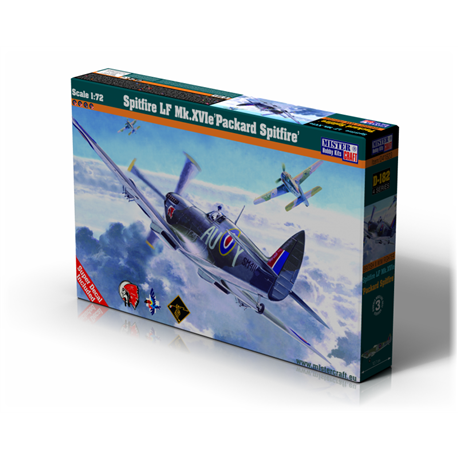No products
Product successfully added to your shopping cart
There are 0 items in your cart. There is 1 item in your cart.
Christmas and New Year
We are dispatching orders every weekday apart from Christmas Day, Boxing Day and New Year's Day.
If you order is time critical, select next day delivery at checkout.
The shop in Sandown is closed from 25th December, reopening on 30th December.
 View larger
View larger Spitfire LF Mk.XVI E Packard Spitfire - 1:72 scale model kit
MCD182
Mistercraft
Spitfire LF Mk.XVI E Packard Spitfire
In stock
| Scale | 1:72 scale |
| Material | Plastic |
| Assembly | Kit |
| Finish | Unpainted |
More info
Supermarine Spitfire - British single-seat fighter built at the Supermarine factory in Southampton, England. One of the most famous fighter aircraft used during the Second World War, on which Poles also fought.
Towards the end of 1940, pilots flying the Mk II version began to encounter a new version of the Messerschmitt Bf 109F, which was superior to the Mk II in every respect, including high-altitude performance. As the Griffon-engined version of the Mk IV was not ready for production, due to engine problems, and the Mk III version, did not enter production due to supply shortages of the Merlin XX engine, it was decided to seek a temporary remedy. At the time, Rolls-Royce had developed another version of the Merlin 45 engine that could easily be fitted to airframes of the Mk I or II versions. So it was decided to do just that, and in January 1941, the engine bed structure was strengthened on the Mk II version airframe and a Merlin 45 engine with a starting power of 1440 hp was fitted (later variations of the Merlin 46, 50 and 50A were used). This engine had a new single-stage compressor, which improved the machine's high-altitude performance. The new engine allowed a higher top speed and climb rate. Metal covering of the ailerons was also introduced, instead of canvas as in previous versions, by which the forces required to control the machine were reduced.
With these changes, the aircraft proved to be at least an equal opponent to the new Bf 109F version and had comparable performance to the Mk III version. In March 1941, it was decided to start serial production of such a modified machine. Initially, two types of wings were used on which different armament could be mounted, hence two sub-versions were created: the Mk Va (type A wing) - 8 km 7.7 mm calibre and the Mk Vb (type B wing) - 2 20 mm cannon and 4 km 7.7 mm. From October 1941, a completely new Type C wing (originally developed for the Mk III version) began to be used, in the Vc subversion, in which the main spar was strengthened and moved forward by 2 inches (5.08 cm). Various armament variants could be used on this type: 4 20 mm cannons or combinations of armament from Type A or B. In practice, 2 20 mm calibre cannons were used, but with a reserve of 120 per cannon and 4 km with a reserve of 350 per km. In addition, a bomb weighing up to 113 kg could be suspended under each wing. A total of 6478 machines of this version were produced (as of spring 1941), 94 as Va, 3923 as Vb and 2447 as Vc.
On some of the machines under the nose, filters were fitted to the carburettor air intake, adapting the machines for operations in desert conditions (North Africa), but this resulted in a decrease in machine performance.
Kit contents:
Model aircraft
Assembly instructions in Polish.
U.S.A USAF aviation 4th Squadron FN 951 pilot Captain Frank Hill airbase North Africa 1943.
Plastic model glue with brush
Extras:
Aviation U.S.A USAF 4th Squadron ER 178 pilot Robert Levine airbase La Sebala Tunisia 1943
United Kingdom Air Force RAF 92 Squadron BR476 pilot H. Wedgewood airbase Egypt October 1942
Polish Air Force .Polish Fighting squadron 145 RAF Bu Grara Airfield airbase Tunisia 1943
Polish Air Force, Squadron 317 RAF Helwan Airbase Egypt 1943.
Polish Air Force, RAF 244 Squadron EP-210 Wing Royal Air Force base Egypt November 1943

